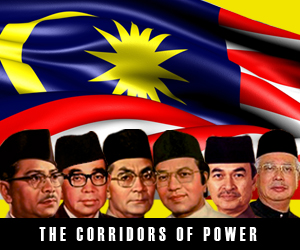
When Mahathir took over as PM he launched his Look East Policy. At that time China was not an economic power yet like Japan, South Korea and Taiwan. Today China is, so Najib has added China to the list of Look East Policy countries. And Mahathir and his Chinese DAP supporters are very angry and accuse Najib of selling Malaysia to China just like how Mahathir sold Malaysia to Japan, South Korea and Taiwan 36 years go.
THE CORRIDORS OF POWER
Raja Petra Kamarudin
What Deputy Prime Minister Ahmad Zahid Hamidi said (SEE THE NST NEWS REPORT BELOW) is actually very true. I have read many comments by critics of Prime Minister Najib Tun Razak alleging that he has sold Malaysia to the Chinese. Some even argue that this is the reason why Malaysia should promote Chinese education and Chinese schools.
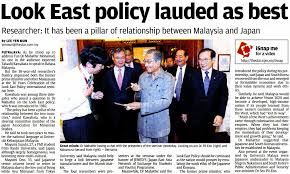
When Tun Dr Mahathir Mohamad took over as Prime Minister in 1981, the first thing he did was to launch the Look East Policy (READ MORE IN ‘THE MAHATHIR YEARS’ BELOW). Basically Mahathir wanted to reduce Malaysia’s dependence on Europe and the West and shift it to Japan, South Korea and Taiwan instead (in the early 1980s China was not yet an economic power). He even sent one of his sons to Japan for his education, who Mahathir hopes is going to be the next Prime Minister of Malaysia..
You can read the details in the paper below (‘The Mahathir Years’) but the bottom line is Mahathir saw Japan, South Korea and Taiwan (China not included yet at that time) as the new emerging economic powers while Europe and the West are in their sunset years. So Mahathir wanted to be on the side of the winners and not on the side of the losers.
Today, China is where Japan, South Korea and Taiwan were 40 years or so ago. And Mahathir never made any official announcement that Malaysia’s Look East Policy has ended and that we should now look elsewhere. Hence, based on Mahathir’s Look East Policy, it is logical that China be added to the list of the other eastern countries such as Japan, South Korea and Taiwan
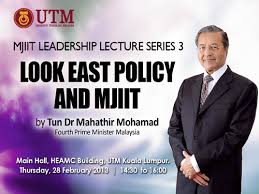
Is Mahathir saying that his Look East Policy was a huge mistake and actually made it worse for Malaysia during the Asian Financial Crisis in 1997, like some people allege? That is what some experts say so Mahathir is free to admit or deny this. Malaysia is estimated to have lost between RM100 billion to RM200 billion due to Mahathir’s stupid economic policies, allege many people, which today is worth three times that amount.
Mahathir started the Look East Policy 36 years ago. The Look East Policy, just like his Wawasan 2020, is still applicable and has never been officially ended. So what is the big deal about China being added to the list of countries such as Japan, South Korea and Taiwan? Or is this just another excuse to attack Najib since the 1MDB issue is unable to bring down the Prime Minister?
And what is surprising is many Chinese attack Najib and accuse him of selling Malaysia to the Chinese. If I were to criticise Najib for ‘selling’ Malaysia to the Chinese by allowing Chinese education and Chinese schools in Malaysia I can bet you RM1 million that the Chinese will label me a racist. Apa lagi Cina mahu?
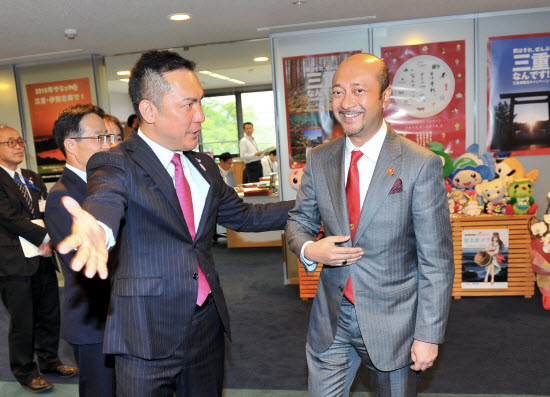
Kedah Menteri Besar Mukhriz Mahathir selling Kedah to Japan
**********************************************
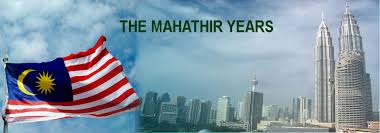
THE MAHATHIR YEARS (www.mtholyoke.edu/)
Look East Policy
“In the early 1980s, the Western nations appeared to have lost their drive. They were enmeshed in an oil crisis and seemingly unable to overcome economic stagnation at a time when vibrant new economic energy was virtually exploding in Japan, South Korea and Taiwan. For me, it was a natural conclusion that if we were to emulate the success of foreign nations, the most valuable role models were no longer in Europe or the U.S., but rather in our own backyard. We had to look East.”
Mahathir wrote in his book “A New Deal for Asia”. [Somun 115]
Prior to Looking East
Upon achieving independence, Malaysia’s trade relations with the Japanese increased, whereby the first Japanese investment in Malaysia was the joint-venture of a textile manufacturing project undertaken in 1957. As the years passed by, the number of joint projects with Japan increased to over 45 projects by 1970s. By 1980, Japan was Malaysia’s main trading partner with a total trade of USD 4 billion.
Another reason that encouraged the Look East Policy was a Malaysian government-supported agency, Permodal Nasional Berhad (National Investment Board) managed to take over a British-owned plantation group, Guthrie in 1981. Guthrie was listed on the London Stock Exchange during the early 1980s. Following the change of ownership, the London authorities tightened London Stock Exchange rules, making it harder for “future takeover raids” [Welsh ed. 320]. In Mahathir’s view, this was a form of retaliation towards Malaysia’s control over Guthrie and an example of the practice of double standards by the West [Welsh ed. 320]. Mahathir believed that if the British had done a similar take over in a non-white country, it would have been praised in the British media instead of being implied as a stealthy move. As a counter attack, Mahathir launched the “Buy British Last” campaign.
Seeing that Japan had managed to sustain a high economic growth from after the Second World War and became the second largest economy in 1981, the whole world were by then awed at Japan’s economic success. Singapore too initiated a “Learn from Japan” campaign in 1978, it was only time before Malaysia decided to learn from the Japanese as well.
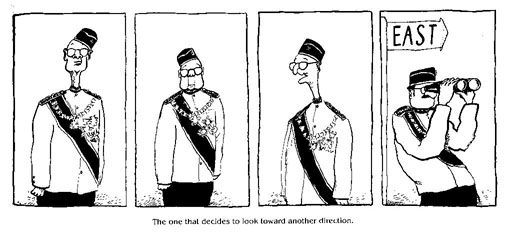
[Lat, Berita Publishing Sdn. Bhd.]
The Policy
The Look East Policy was launched in late 1981, at the beginning of Mahathir’s career as Prime Minister. The policy did not just focus on Japan, but South Korea and Taiwan as well. Looking East also did not mean following all Eastern habits blindly or trading solely with these countries, it was learning the good values of the East, particularly their work ethics and their technological skills. There was a huge emphasis on developing co-operative projects to facilitate the transference of technology that would benefit both sides.
As Mahathir said: “We never intended to simply ‘ape’ everything Japanese; indeed, we were well aware that outright copying would be quite impossible considering the quite different ethnic and historical backgrounds of our countries. Neither did ‘Look East’ mean that we were going to completely reject positive elements from the West.” [Somun 115]
During the initiation of the policy, Mahathir mentioned that he was willing to commit full responsibility for the outcome of the policy, his specific words were that he would either “sink or swim” with it. [Rajendran 106]
Among the policies that were contracted to Japanese companies was the Dayabumi complex that cost RM 400 million. In addition, the construction of the Penang Bridge and some of the highways were also awarded to South Korean firms.
PROTON
The most famous project embarked upon during the Look East Policy years was the formation of the first national car, the Proton Saga project. In order to implement the project, the national car company – Perusahaan Otomobil Nasional Sendirian Berhad (PROTON) was formed in 1983. The project was first discussed in 1981 and within 19 months, the manufacturing plant was already built. Since the car industry is depended on other industries, like rubber, electronics and metalwork, the launch of the nation’s own car industry would support the market demand for these raw materials.
The project was also made possible with the joint venture between the Heavy Industries Corporation of Malaysia (HICOM) and Japan’s Mitsubishi. In that partnership, Malaysia held a 70% share in the venture and the capital needed for the project was provided by the Japanese in the form of loans.
Soon after the project launching took place, workers were sent to Japan for up to six months to undergo intensive training programs. By 1988, the percentage of Japanese staff involved in the project was reduced to two-thirds.
The first Proton Saga car rolled off the assembly line in 1985. It became an instant hit in the country and was apparently the most popular car in Malaysia during the first two years after its launch [Rajendran 96].
The car dealer that was responsible for marketing the Proton Saga, Edaran Otomobil Nation (EON) carried out the exportation of the cars and the Proton Saga actually won two British awards.
Sogo Shosha
The phrase sogo shosa means “a general merchant or trader” [Rajendran 99]. The Japanese labeled Japanese corporations that venture in international trade and in a wide range of commodities. Mahathir was particularly impressed with the performance of these sogo shosas. This resulted in the formation of Malaysia’s own sogo shosa that is Sime Darby Pernas Trading Corporation in 1983.
Mahathir viewed that these large corporations would enable Malaysia to expand its manufacturing industry and be actively involved in the international market. Malaysia was also incapable of providing a large enough domestic market for the intended amount of produce planned, thus the need for these type of corporations arose.
Outcome and Criticisms
Not long after the introduction of Look East, the Japanese economy experienced many years of stagnation and recession after its economic bubble burst during the early 1990s. Furthermore, the Japanese economy also suffered during the Asian Financial Crisis. These factors decreased the keen interest of emulating the Japanese model.
In other aspects, the Proton Saga project was criticised for costing too much, which was about RM1.5 billion. The Malaysian sogo shosa also did not fare well in the international market due to the strong competition from Japanese, Taiwanese and South Korean sogo shosas. The Japanese were at an advantage as they were impeccable in their service and they had good links with the governments and banks. Moreover, the Malaysian sogo shosa was constructed at a time when recession was taking place in the country.
To some Malaysians, the policy was a success for bringing about the rapid economic growth during the years before the Asian Financial Crisis. Instead, other Malaysians credit the economic deterioration experienced after the Asian Financial Crisis to the Look East Policy model.
According to Khadijah Md. Khalid, the main objective of the policy has yet to be fully achieved as “Malaysia’s overall work productivity remains low” [Welsh ed. 329].
**********************************************
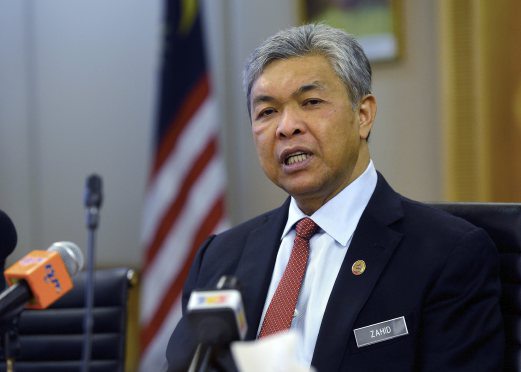
(NST) – Deputy Prime Minister Datuk Seri Dr Ahmad Zahid Hamidi took a swipe at Parti Pribumi Bersatu Malaysia president Tan Sri Muhyiddin Yassin for claiming investments from China would rob Malaysians of business opportunities.
“Before, when Japan invested in Malaysia, nobody said the Japanese were robbing (economic) opportunities from domestic investors. What about when the Koreans were one of the biggest investors in Malaysia? What about the Singaporeans…are they not robbing domestic investors of opportunities?”
“We have to be open… (we have to have) open minds and open hearts by inviting foreign direct investments (FDI).” Speaking to Malaysian media on the third day of a six-day working visit to China, Zahid said he was of the opinion that, for the sake of the country, differences should be set aside as foreign investments would spur economic growth.
“Economic growth is dependent on the volume of FDI into our country. Of course, domestic investment has to be given priority, but the capacity of domestic investors is limited, especially when it comes to injecting capital for new technology.”
Muhyiddin, who has been critical of deals struck between Malaysia and China, was reported to have claimed that Malays and Malaysian Chinese were unhappy that foreign investors from China were “robbing local businesses” of economic opportunities.


No comments:
Post a Comment
Note: Only a member of this blog may post a comment.